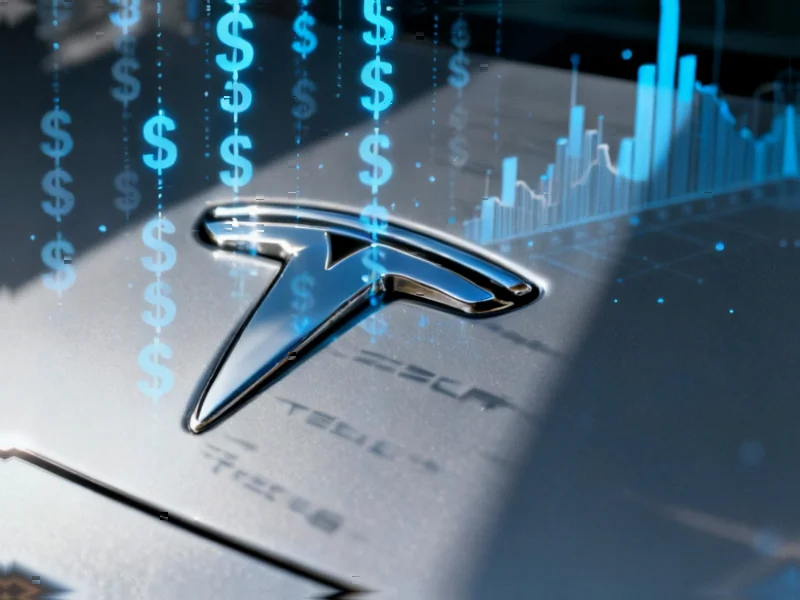Behind Tesla’s Profit Decline: A Deeper Look at the Numbers
While Tesla celebrated record vehicle deliveries in the third quarter, the electric vehicle pioneer faced a significant 29% drop in adjusted net income, falling to $1.8 billion. This decline occurred despite a robust 12% revenue increase to $28.1 billion, highlighting the complex financial dynamics facing the automotive disruptor. The company‘s reported net income of $1.4 billion fell short of analyst expectations, revealing underlying challenges beneath the surface of strong sales figures.
Table of Contents
The Regulatory Credit Revenue Collapse
One of the most dramatic shifts in Tesla’s financial structure has been the 44% plunge in regulatory credit revenue, which dropped to $417 million this quarter. This decline stems directly from the US government’s decision to reduce fines for non-compliance with car emissions standards to zero, effectively dismantling the trading schemes that previously generated substantial income. The Financial Times previously reported that Tesla earned approximately $2.8 billion from these trading schemes last year, with about three-quarters originating from US markets.
The timing of this regulatory change couldn’t be more challenging for Tesla, as the company simultaneously ramps up spending on its ambitious technological transformation. This perfect storm of declining traditional revenue streams and rising investment demands creates a pivotal moment for the company’s financial strategy.
Massive Operating Expense Surge: The AI and Robotics Bet
Tesla’s operating expenses skyrocketed by 50% to reach $3.4 billion, reflecting Elon Musk’s aggressive pivot toward artificial intelligence, autonomous driving, and robotics. The company has been investing heavily in advanced chips and computing infrastructure to power its ambitions beyond traditional automotive manufacturing. This strategic redirection represents one of the most significant corporate transformations in modern business history, as Tesla evolves from an electric vehicle manufacturer to a comprehensive technology company.
The substantial capital allocation toward AI development, robotaxi preparation, and humanoid robot projects demonstrates Musk’s conviction that Tesla’s future lies in autonomous technology and artificial intelligence. However, this transition comes with immediate financial consequences, as these investments require massive upfront spending before potentially generating returns.
Political Headwinds and Market Dynamics
Despite expectations that Musk’s political alignment would benefit Tesla, the company has faced challenges from multiple directions. The backlash surrounding Musk’s political activism, combined with evolving US electric vehicle policies and his public disagreements with political figures, has created additional uncertainty. Meanwhile, customers rushing to purchase electric vehicles before the September 30 expiration of the $7,500 federal tax credit created a temporary sales surge that may not be sustainable.
These factors illustrate how Tesla’s fortunes are increasingly tied to broader political and regulatory environments, moving beyond pure manufacturing and technology considerations. The company must now navigate complex political landscapes while maintaining its innovation trajectory., as as previously reported
The Leadership Compensation Battle
As Tesla prepares for its November 6 annual meeting, the company faces a crucial vote on a proposed $1 trillion share package for Elon Musk. The board argues this compensation plan is essential for motivating and retaining Musk’s leadership, while proxy advisers Institutional Shareholder Services and Glass Lewis have recommended shareholders reject the proposal. These advisory firms cite the package’s “striking magnitude” and the absence of binding terms to ensure Musk’s ongoing commitment to Tesla as he manages multiple companies including SpaceX and xAI.
This compensation debate highlights the ongoing tension between rewarding visionary leadership and ensuring corporate governance standards. The outcome could significantly influence Tesla’s strategic direction and Musk’s level of involvement in the company’s daily operations.
Looking Ahead: Tesla’s Evolving Business Model
Tesla’s current financial results reflect a company in transition, balancing its core automotive business against ambitious technological expansions. The record 497,099 vehicle deliveries demonstrate strong market demand, but the profitability challenges reveal the costs of transformation. As regulatory credit revenues diminish and AI investments accelerate, Tesla must demonstrate that its new technological directions can eventually generate returns comparable to its traditional revenue streams.
The coming quarters will be critical for assessing whether Musk’s strategic bets on artificial intelligence and robotics can create sustainable value or if the company needs to recalibrate its approach to balance innovation with financial stability. For industry observers and investors, Tesla represents a fascinating case study in corporate evolution and the financial challenges of technological transformation.
Related Articles You May Find Interesting
- UK Regulator Confirms Apple and Google Hold Strategic Market Status in Mobile Se
- UK Regulator’s Landmark Ruling Puts Apple and Google Under Enhanced Digital Mark
- Reddit Escalates Legal Battle Over AI Data Scraping in Federal Copyright Lawsuit
- Apple Removes Troubled Dating Safety App Tea Over Privacy and Moderation Failure
- Coinbase’s AI Agent Integration Paves Way for Autonomous Digital Commerce
This article aggregates information from publicly available sources. All trademarks and copyrights belong to their respective owners.
Note: Featured image is for illustrative purposes only and does not represent any specific product, service, or entity mentioned in this article.




cb6vdw